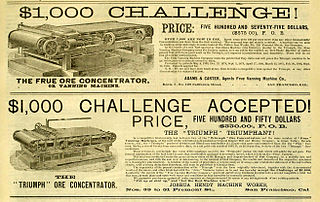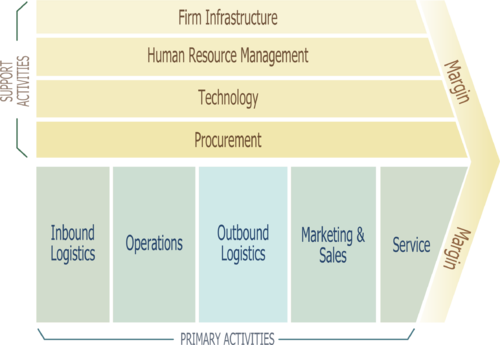
In commerce, supply chain management (SCM) deals with a system of procurement, operations management, logistics and marketing channels, through which raw materials can be developed into finished products and delivered to their end customers. A more narrow definition of supply chain management is the "design, planning, execution, control, and monitoring of supply chain activities with the objective of creating net value, building a competitive infrastructure, leveraging worldwide logistics, synchronising supply with demand and measuring performance globally". This can include the movement and storage of raw materials, work-in-process inventory, finished goods, and end to end order fulfilment from the point of origin to the point of consumption. Interconnected, interrelated or interlinked networks, channels and node businesses combine in the provision of products and services required by end customers in a supply chain.
In economics, internationalization or internationalisation is the process of increasing involvement of enterprises in international markets, although there is no agreed definition of internationalization. Internationalization is a crucial strategy not only for companies that seek horizontal integration globally but also for countries that addresses the sustainability of its development in different manufacturing as well as service sectors especially in higher education which is a very important context that needs internationalization to bridge the gap between different cultures and countries. There are several internationalization theories which try to explain why there are international activities.
The knowledge economy, or knowledge-based economy, is an economic system in which the production of goods and services is based principally on knowledge-intensive activities that contribute to advancement in technical and scientific innovation. The key element of value is the greater dependence on human capital and intellectual property as the source of innovative ideas, information and practices. Organisations are required to capitalise on this "knowledge" in their production to stimulate and deepen the business development process. There is less reliance on physical input and natural resources. A knowledge-based economy relies on the crucial role of intangible assets within the organisations' settings in facilitating modern economic growth.
In the field of management, strategic management involves the formulation and implementation of the major goals and initiatives taken by an organization's managers on behalf of stakeholders, based on consideration of resources and an assessment of the internal and external environments in which the organization operates. Strategic management provides overall direction to an enterprise and involves specifying the organization's objectives, developing policies and plans to achieve those objectives, and then allocating resources to implement the plans. Academics and practicing managers have developed numerous models and frameworks to assist in strategic decision-making in the context of complex environments and competitive dynamics. Strategic management is not static in nature; the models can include a feedback loop to monitor execution and to inform the next round of planning.
Marketing management is the strategic organizational discipline which focuses on the practical application of marketing orientation, techniques and methods inside enterprises and organizations and on the management of a firm's marketing resources and activities.
In business, a competitive advantage is an attribute that allows an organization to outperform its competitors.
Productivity is the efficiency of production of goods or services expressed by some measure. Measurements of productivity are often expressed as a ratio of an aggregate output to a single input or an aggregate input used in a production process, i.e. output per unit of input, typically over a specific period of time. The most common example is the (aggregate) labour productivity measure, one example of which is GDP per worker. There are many different definitions of productivity and the choice among them depends on the purpose of the productivity measurement and data availability. The key source of difference between various productivity measures is also usually related to how the outputs and the inputs are aggregated to obtain such a ratio-type measure of productivity.
Eco-efficiency refers to the delivery of goods and services to meet human needs and improve quality of life while progressively reducing their environmental impacts of goods and resource intensity during their life-cycle.
International business refers to the trade of Goods and service goods, services, technology, capital and/or knowledge across national borders and at a global or transnational scale.

In economics, competition is a scenario where different economic firms are in contention to obtain goods that are limited by varying the elements of the marketing mix: price, product, promotion and place. In classical economic thought, competition causes commercial firms to develop new products, services and technologies, which would give consumers greater selection and better products. The greater the selection of a good is in the market, the lower prices for the products typically are, compared to what the price would be if there was no competition (monopoly) or little competition (oligopoly).
The following outline is provided as an overview of and topical guide to business management:
The digital economy is a portmanteau of digital computing and economy, and is an umbrella term that describes how traditional brick-and-mortar economic activities are being transformed by the Internet and World Wide Web technologies.
New business development concerns all the activities involved in the creation of a new enterprise and in realizing new business opportunities, including product or service design, business model design, and marketing.
An extended enterprise is a loosely coupled, self-organizing network of firms that combine their economic output to provide products and services offerings to the market. Firms in the extended enterprise may operate independently, for example, through market mechanisms, or cooperatively through agreements and contracts. They provide value added service or product to the OEM.
Creating shared value (CSV) is a business concept first introduced in a 2006 Harvard Business Review article, Strategy & Society: The Link between Competitive Advantage and Corporate Social Responsibility. The concept was further expanded in the January 2011 follow-up piece entitled Creating Shared Value: Redefining Capitalism and the Role of the Corporation in Society. Written by Michael E. Porter, a leading authority on competitive strategy and head of the Institute for Strategy and Competitiveness at Harvard Business School, and Mark R. Kramer, of the Kennedy School at Harvard University and co-founder of FSG, the article provides insights and relevant examples of companies that have developed deep links between their business strategies and corporate social responsibility (CSR). Porter and Kramer define shared value as "the policies and practices that enhance the competitiveness of a company while simultaneously advancing social and economic conditions in the communities in which it operates", while a review published in 2021 defines the concept as "a strategic process through which corporations can turn social problems into business opportunities".
Media management is a business administration discipline that identifies and describes strategic and operational phenomena and problems in the leadership of media enterprises. Media management contains the functions strategic management, procurement management, production management, organizational management and marketing of media enterprises.
A global value chain (GVC) refers to the full range of activities that economic actors engage in to bring a product to market. The global value chain does not only involve production processes, but preproduction and postproduction processes.
An agricultural value chain is the integrated range of goods and services necessary for an agricultural product to move from the producer to the final consumer. The concept has been used since the beginning of the millennium, primarily by those working in agricultural development in developing countries, although there is no universally accepted definition of the term.
Global Production Networks (GPN) is a concept in developmental literature which refers to "the nexus of interconnected functions, operations and transactions through which a specific product or service is produced, distributed and consumed."
Co-opetition or coopetition – simultaneous competition and cooperation – is an important philosophy or strategy that goes beyond the conventional rules of competition and cooperation to achieve advantages of both. Global co-opetition, an application of co-opetition in a global context, is first systematically addressed in Luo’s (2004) book “Coopetition in international business”. According to this book, global co-opetition refers to the simultaneous competition and cooperation between multinational enterprises (MNEs) and their geographically dispersed business stakeholders such as global rivals, global suppliers, global distributors, global alliance partners, and foreign governments as well as among foreign subsidiaries within an MNE.



